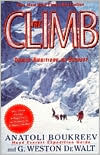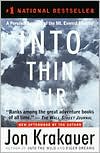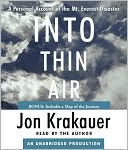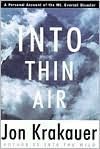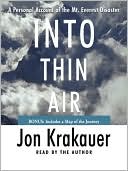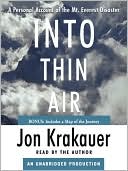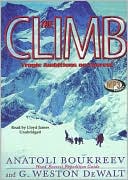Climb: Tragic Ambitions on Everest
In May 1996 three expeditions attempted to climb Mount Everest on the Southeast Ridge route pioneered by Sir Edmund Hillary and Tenzing Norgay in 1953. Crowded conditions slowed their progress. Late in the day twenty-three men and women-including expedition leaders Scott Fischer and Rob Hall-were caught in a ferocious blizzard. Disoriented and out of oxygen, climbers struggled to find their way down the mountain as darkness approached. Alone and climbing blind, Anatoli Boukreev brought...
Search in google:
As the climbers of the 1996 Mt. Everest disaster vanished into thin air, one man had the courage to bring them down alive...On May 10, 1996, two commercial expeditions headed by expert leaders attempted to scale the world's largest peak. But things went terribly wrong. Crowded conditions, bad judgement, and a bitter storm stopped many climbers in their tracks. Others were left for dead, or stranded on the frigid mountain. Anatoli Boukreev, head climbing guide for the Mountain Madness expedition, stepped into the heart of the storm and brought three of his clients down alive. Here is his amazing story-of an expedition fated for disaster, of the blind ambition that drives people to attempt such dangerous ventures, and of a modern-day hero, who risked his own life to save others.. Booknews Weaving together first-hand accounts by the head tour guide of the Mountain Madness expedition and an investigative narrative based on interviews with other expedition members and mountain climbing specialists, the authors explore the conditions that led to the May, 1996 disaster on Everest. The authors counter many of the claims that were made in Jon Krakauer's , written on the same subject.
Climb\ Tragic Ambitions on Everest \ \ By Anatoli Boukreev \ Rebound by Sagebrush\ Copyright © 1998 Anatoli Boukreev\ All right reserved.\ ISBN: 9780613125796 \ \ \ \ \ CHAPTER ONE\ MOUNTAIN MADNESS\ A star, one that didn't belong, appeared in the night sky over the Himalaya in March 1996. For several consecutive days the star had been moving over the mountains, its trailing tail fanning into the darkness. The "star" was the comet Hyakutake. It was the beginning of the spring season on Mount Everest (8,848 m), that interval of time between the decline of winter and the coming of the summer monsoons when, historically, expeditions to Everest have been most successful, and Hyakutake's stellar trespass was considered an ominous sign by the Sherpas in whose villages the cosmic smear was a matter of concern and conversation.\ The Sherpas, an ethnic group indigenous to Tibet, many of whom now live primarily in the highland valleys of Nepal, derive a substantial part of their family incomes from the mountaineering expeditions that come to the Himalaya. Some work as porters, cooks, and yak drivers; others take on the more dangerous and more lucrative roles as high-altitude support personnel, joining foreign expeditions in their ultimate wager: skill and endurance pitted against a physical environment that precludes prolongedhuman existence.\ By 1996, in the seventy-five years that had passed since the first attempt was made on its summit in 1921, more than 140 climbers had died on Mount Everest. Almost 40 percent of those fatalities had been Sherpas. So, when the natural orders were disturbed, the Sherpas took notice.\ Kami Noru Sherpa is in his midthirties, married, and the father of three children. He is one of the new generation of Sherpas who have, since the 1950s, exchanged their traditional dress for Gore-Tex parkas and embraced the cash economy of mountaineering. In 1996, as he had been for the past several years, Kami Noru Sherpa was hired by Himalayan Guides, a commercial adventure company based in Edinburgh, Scotland, to serve as a sirdar (manager) for an Everest expedition.\ Headed by the bearded and burly Englishman Henry Todd a fifty-one-year-old former rugby player turned expedition packager, Himalayan Guides had the distinction of never having lost a client. Todd's practicality and good luck in the mountains and his cooperative relationship with Kami Noru Sherpa had brought them both a measure of success in the Himalaya.\ In the spring of 1995, Todd had offered a commercial expedition to Mount Everest, taking his client climbers to the mountain from the north side, from Tibet. The expedition had been an unqualified success. Eight climbers from his expedition had made it to the top on a single day. After such success, Todd and Kami Noru Sherpa were riding high, but not to the point of overconfidence. In fact, in March 1996, they were both anxious about the season ahead.\ Kami Noru Sherpa had pointed out the errant "star" to Todd, and Todd recalls that Kami was disturbed by its presence. When Todd asked Kami Noru Sherpa what it meant to him and the other Sherpas, Kami said simply, "We don't know. We're not liking it."\ "It [the comet] had been there for some time," said Todd, "and for the Sherpas it presaged things not going terribly well." A superstition, yes, thought Todd, but a matter of serious concern, because the people who knew the mountain best said it mattered.\ To the uncertain meaning of the stellar disruption Todd could add his own problem. As of late March the winter snows had yet to melt to the point where his yak caravan could safely travel the trekking trail that led to the Mount Everest Base Camp (5,300 m). Some Sherpa porters were getting through on a narrow snow-packed trail, but hardly anyone else. Since the quantity of supplies required by expeditions requires the carrying power and capacity of yak teams, the pace of his supply effort had been slowed considerably. It was a headache, not yet a nightmare, but a problem that could grow to that proportion if the trails remained impassable for much longer. The weather window for attempts on the Everest summit stays open only for a brief period and closes abruptly with the coming of the monsoon season. If expeditions are not adequately provisioned when the time for their summit bid arrives, they might as well have never traveled to the mountain.\ As almost everyone does in the face of an uncertainty, Todd and Kami Noru Sherpa took actions that might forestall or minimize the problems that each of them faced. In Kathmandu, Nepal (1,400 m), where he was addressing an accumulation of logistical problems and waiting for snows north of him to further melt, Todd took delivery of several cases of J & B Scotch, a gift from one of his climbers who had been sponsored, in part, by the distillery. Giving careful packing instructions to his Sherpas who would be freighting the spirits to his Base Camp, Todd more than half-anticipated some nights when the libation might serve to take off the edge. Kami Noru Sherpa, not a Scotch drinker, prepared for what was ahead in his own way.\ On March 29, in his slate-roofed stone house in Pangboche (4,000 m), a village niched into a series of terraces overlooking the trekking trail that winds to the base of Mount Everest, Kami Noru Sherpa held a puja, a ritual thanks to the mountains and a prayer of blessing. At sunrise, in a large, second-floor room above a grain storage area, five Buddhist monks in maroon and saffron robes seated themselves in a circle. Encircling them were Kami Noru Sherpa and several other of the Sherpas from Pangboche who had been hired to work on Everest. A wavering, pale yellow glow from yak-butter lamps and a few stray beams of morning sun offered the only light, nicking here and there the weave of reds and blues in the Tibetan rugs on the handsawn plank floors. Spirals of smoke drifted from a cooking fire, and the rich, sweet smell of juniper branches escaped as they were burnt in offering.\ The chants of the monks played off the walls and echoed back into their repetition, and with every redoubling came a calm and peace, an assurance that, if the Sherpas honored it, the mountain would protect them and deliver them home. As the puja ended, the monks gave each of the Sherpas a protective amulet, a knotted loop of red string. With quiet reverence and a bow of thanks, each of them accepted the gift and placed the string around their necks.\ Over the next few days, as the snows continued to melt, Kami Noru Sherpa and the Sherpas would leave their homes and trek to the Everest Base Camp, where they would join the expeditions that had hired them. Working for anywhere from $2.50 to $50 a day, they would help establish camps, carry loads up the mountain, and cook for and serve the climbers who were coming to Everest in ever greater numbers.\ In the early 1980s the number of climbers and expedition support personnel who would gather in the Everest Base Camp during the spring season could have fit into one Paris metro car. In 1996, more than four hundred people would eventually come up the trail and pitch their tents, giving the camp the appearance of a rock concert encampment. One climber described the 1996 Everest Base Camp as having all the appearances of "a circus, except there were more clowns in our tents." By many accounts, there were some real "punters" on the mountain in 1996.\ A Taiwanese expedition headed by Makalu Gau was the source of endless jokes, which thinly veiled serious concerns about his team's qualifications and their ability to get off the mountain alive. One climber said, "I'd as soon have been on the mountain with the Jamaican bobsled team." And then there was the Johannesburg Sunday Times Expedition, which had publicly been embraced by Nelson Mandela. Stories about the relative inexperience of many of their climbers and questions about the veracity of their wiry and short-tempered leader, Ian Woodall, were roundly exchanged over Henry Todd's Scotch.\ American climber and Everest veteran Ed Viesturs was heard to say, "A lot of people are up here who shouldn't be." Viesturs, thirty-seven, was working as a guide and doubling as an on-camera talent for the MacGillivray Freeman IMAX/IWERKS Expedition, headed by the American climber and filmmaker David Breashears. The film production, with one of the largest budgets ever committed to a documentary about Everest, was to result in a large-format film to be released in 1998. Designed to be projected in theaters outfitted with wraparound screens and state-of-the-art sound systems, the film would offer virtual, armchair Everest.\ Breashears, in his early forties, was something of a legend in the Himalaya. More than any other climber, except for perhaps Sir Edmund Hillary, who with Tenzing Norgay summited Mount Everest for the first time in 1953, Breashears had been successful in making Everest a cash cow, deriving over the years a substantial portion of his income from his activities on the mountain. In 1985, he had the distinction of having guided Texas businessman and millionaire Dick Bass to the summit. Bass, at fifty-five, became the oldest climber to date to make the top. This accomplishment is seen by many as the pivotal point in the history of attempts to climb Everest. The adventuresome and the well-to-do took notice. If a fifty-five-year-old with motivation and discretionary income could do it, anybody could! Commercial expedition companies were spawned to address the demand that was stimulated and to service customers who could pay big dollars for big mountains.\ As Breashears and his IMAX/IWERKS expeditionary force trekked toward the Everest Base Camp, they made an impression. Not far from Kami Noru Sherpa's house in Pangboche, several members of the expedition had stopped at a teahouse and occupied some of its tables. They ordered tea, but refused the offer of local food, preferring instead home-bought goodies pulled from expedition bags. One veteran at the Everest Base Camp who found the team a little too coiffed and cool referred to them as the "Gucci guys."\ Tenting nearby the IMAX/IWERKS Expedition at the Everest Base Camp were Henry Todd's Himalayan Guides expedition and several other commercial expeditions that, like Todd's, had brought paying clients to the mountain. Among the "dollar dogs," as one Everest chronicler has privately labeled commercial expedition members, was the Adventure Consultants Guided Expedition, headed by New Zealander Rob Hall.\ Hall, black bearded and imposing with a "Lincolnesque" appearance, had an intensity and quiet reserve that made many think he was much older than his thirty-five years. Since 1990, when his company began taking expeditions to Everest, Hall had taken a record thirty-nine climbers (clients and expedition personnel combined) to the top of Everest. His company's "adverts" that ran in international climbing magazines were large, alluring, and not immodest. One that appeared in early 1995 read: "100% Success! Send for Our Free Color Brochure." One hundred percent that is until May 1995, when he turned all of his clients back from their bid to the summit as deep snows at higher elevations had slowed their progress. Nobody had made the summit.\ In 1996, Rob Hall was back, ready to go again, determined, if he could, to get back into the win column. The pressure was on. Success, not turnarounds, brought in new business, and there was an additional challenge in 1996: a new competitor in the game.\ Scott Fischer from West Seattle, Washington, was coming to the mountain. Six foot four with a chiseled, symmetrical face and long, flowing blond hair, he ran his West Seattle, Washington-based adventure company, Mountain Madness, as an extension of his personal ambition: to climb mountains around the world and to have a hell of a time doing it.\ With his talent, good looks, and charm, he was a prime candidate for mountaineering's poster boy. He had a charismatic personality with the drawing power of an industrial magnet. He could attract clients, motivate them, get them to commit, to write their checks and pack their rucksacks. He was a contender, but new to the business of guiding a commercial expedition to Mount Everest.\ His motivation for becoming an Everest "dollar dog," one of his business associates has said, was fairly simple: "I think that he looked at Rob Hall's success and thought ... 'If he can do it, I can do it.' And not in a competitive macho way, but just saying, 'Hey, I'm a really great climber. Why can't I do it, too? ... I'll get clients and I'll go, too.'" Go, too, and make the money, too.\ Mountain Madness's former general manager, Karen Dickinson, described the company's decision to package expeditions to Everest as "kind of the ultimate in high-altitude mountaineering. There was a demand from our clients that we wanted to service or else lose them to the competition. If it goes well, it could be very lucrative, so there was a financial motivation. Of course, I can't stress enough that you're equally as likely to lose your shirt.... It's just a high-stakes game financially."\ Fischer was focused on the potential of the big rewards that could come from running a successful expedition. He had been thinking about changing his life. Karen Dickinson said, "He had turned forty the year before; his business had finally gotten to where he wanted.... He'd climbed K2 [8,611 m]; he'd climbed Everest; he was established as a successful guide.... He was talking about maybe he wouldn't go back to the summit of Everest again, that he would hire people to do that."\ The plan had been loosely sketched, little more than casual conversations between Fischer and Dickinson, but those who knew him best said Fischer was giving more consideration to shaking things up. His personal life, his role in the company, his public persona, everything was up for midlife review.\ Fischer had worked at developing the Mountain Madness business since the early 1980s, but it had never consistently provided him a good, steady income. Climbing had been his thing; the business had enabled that, but he'd never been a headliner, had never played in the big tent. A commercial success on Everest, he knew, could considerably alter the picture. If he could draw enough clients at $65,000 apiece (Hall's asking price), and if he could build a successful big-mountain expedition schedule, he could solve a lot of problems, finance a lot of change.\ Part of the challenge in his birthing a new direction was his lack of international visibility. He didn't have the reputation of many of the other players in high-altitude mountaineering who graced the covers and pages of climbing magazines and equipment catalogs. As his efforts as an expedition leader had progressed, his personal climbing career had taken a back seat. He had come to feel, as one friend put it, "that he wasn't getting his due in the media ... the press didn't treat him fairly, that he wasn't respected; his name wasn't really brought up much; he wanted to be recognized."\ His difficulty, as some of those around him saw it, was his image: accomplished climber, instructor, guide, and photographer, yes, but also swashbuckling, devil-may-care, good-time guy. These characterizations made for a certain kind of notoriety, but it wasn't the kind of image that made the big-dollar clients comfortable or drew the lucrative Fortune 500 sponsorships. He was, for that league, perhaps too "dicey." A successful Everest expedition, one with a lot of visibility, could "skew the do."\ Working the phones from their West Seattle office, Dickinson, Fischer, and their staff massaged the client list to promote their expedition, and they mailed out hundreds of promotional brochures, two-color productions that had the graphic allure of a lawn-mower operator's manual. They didn't have the luster or panache of Rob Hall's advertising, but they were on the street with the word: "Climbers on the 1996 team will get a crack at the highest mountain in the world.... We'll build a pyramid of camps, each stocked from the one below. The guides and high-altitude Sherpa staff will fix rope, establish and stock camps, and provide leadership for all summit attempts. Climbers will carry light loads, saving their strength for the summit."\ For Fischer's competitors in the Everest game, it was not good news to hear that he'd decided to move into the market. Fischer's easygoing style and his efforts in packaging expeditions to the remotest destinations in Africa, South America, and Asia had attracted a lot of customers from around the world, and his success, if it came, would be especially problematic for Rob Hall, who had been incredibly successful in recruiting American clients for his Everest expeditions.\ *\ In an effort to generate more press for both Mountain Madness and himself, Fischer and his staff trolled for media attention as aggressively as they did for client climbers, and early on in their efforts they had a bite, one that promised a serious opportunity.\ Outside, the leading outdoor-recreation magazine in the United States, wanted to sponsor a climber-writer, Jon Krakauer, a Seattle-based journalist and best-selling author whom they were commissioning to write a feature article on the boom in commercial expeditions to Mount Everest. They wanted to buy a slot on Fischer's team for Krakauer, but they wanted a deal, a good deal.\ Keen to the opportunity that having such an accomplished journalist on their roster could bring, Mountain Madness aggressively worked the executives of Outside. They explored a variety of trades and exchanges that would work to each organization's advantage and kept the heat turned up. A business associate of Fischer's recalled, "Karen [Dickinson] was just lighting a fire right and left underneath Outside, saying, 'Yeah!'"\ Negotiations went well, and Fischer was excited about the potential relationship. In exchange for a discounted price to Outside, Mountain Madness was lobbying for advertising space and a feature story, replete with color photos, that they hoped would contain precious promotional prose. Krakauer was enthusiastic, too, telling one of Fischer's associates that he wanted to climb with Scott's team because Scott's team actually had better climbers and that Scott was a local guy and an interesting character.\ This, Fischer thought, could be the press he was looking for, coverage in a major, mass-market magazine whose demographics had the clusters of "Beemers" and backpackers who could afford big-mountain prices. Dickinson remembered, "There was a long period where we really thought that Jon was going to be on our trip.... And we sort of held open a slot for him, thinking that was his, and we were negotiating heavily with Outside about how the payment might look ... a combination of advertising and just writing us a check."\ But, a Mountain Madness associate recalled, "They were nickel-and-diming her [Dickinson] and basically wanted, I think, Mountain Madness to pick up the whole tab, not just have him go for cost, but less than cost, so Mountain Madness would be going out-of-pocket to have somebody on the climb. You know, come on, get real! ... So, at a certain point, Outside went to Rob [Hall] and said, 'Okay, what will you give it to us for?' and Rob said, 'Less than that.' Bingo!" At the eleventh hour Outside bought Krakauer's ticket from Adventure Consultants.\ A spokesperson for Outside, recalling the magazine's decision to take Hall's offer, said they did not select Adventure Consultants "solely for financial reasons" but had also taken into consideration that Rob Hall had "consistently more experience guiding on Everest, more of a track record in terms of safety, and according to Jon Krakauer, a better oxygen system."\ Fischer was enraged by Outside's decision, saying, "God, it's typical of the media. Typical bullshit." A friend of his remembered Fischer's "paint-peeling" response: "He just thought it was really screwed of Outside to take this idea and run with it, and ... getting all this information from Karen [Dickinson] and then just for a difference of maybe a thousand bucks--I don't know what it was, but it probably wasn't a huge amount--and going with Rob."\ Exit one opportunity, enter another, perhaps a better one. Mountain Madness was able to sign on Sandy Hill Pittman, forty, a Contributing Editor to Allure and to Conde Nast Traveler. Already Pittman had climbed the highest mountain on six of seven continents, but Everest had eluded her. On two previous climbs, one of them guided by David Breashears of the IMAX/IWERKS team, she had turned back before the summit.\ Pittman was a prize. She had more high-altitude experience than Krakauer, and she had an agreement with NBC Interactive Media to do a daily feed to a World Wide Web site (www.nbc.com/everest), and if Fischer could get her to the top, he would have publicity that a Pope in the pulpit couldn't buy. But, he had to get her to the top, and Fischer knew that.\ "I think that first Scott saw her as somebody, kind of a plum," said a friend of Fischer's. "If he gets her to the top, whew! ... She'll write about him; she'll talk about him; she'll carry him on the wave of good fortune she's had." But, if he didn't, he could have a publicity fiasco. An associate has said she could imagine Pittman saying, "It was Scott Fischer; it was Scott Fischer. He wouldn't let me climb; I could have climbed."\ *\ To get his clients to the top, Fischer had secured the services of three guides and promoted their commitment to his potential clients. In his promotional literature he identified the expedition guides as Nazir Sabir of Pakistan, a veteran guide and expedition packager who had climbed several 8,000-meter peaks; Neal Beidleman, an aerospace engineer, a climber, and ultra-marathon runner from Aspen, Colorado; and Anatoli Boukreev.\ Boukreev, thirty-eight, a Russian citizen and resident of Almaty, Kazakhstan, was considered one of the world's foremost high-altitude mountain climbers. By spring 1996 he had climbed seven of the most challenging of the globe's 8,000ers (some of them more than once), and all of those he had climbed without the use of supplementary oxygen.\ \ Continues...\ \ \ \ Excerpted from Climb by Anatoli Boukreev Copyright © 1998 by Anatoli Boukreev. Excerpted by permission.\ All rights reserved. No part of this excerpt may be reproduced or reprinted without permission in writing from the publisher.\ Excerpts are provided by Dial-A-Book Inc. solely for the personal use of visitors to this web site. \ \
PrologueCh. 1Mountain Madness1Ch. 2The Everest Invitation13Ch. 3Doing the Deals25Ch. 4The Clients36Ch. 5The Trail to Everest42Ch. 6Doing the Details50Ch. 7Base Camp58Ch. 8Khumbu to Camp II64Ch. 9Camp II77Ch. 10The First Delays86Ch. 11Toward the Push98Ch. 12The Countdown109Ch. 13Into the Death Zone121Ch. 14To the South Summit133Ch. 15The Last Hundred143Ch. 16Decision and Descent151Ch. 17Snowblind160Ch. 18Walk or Crawl170Ch. 19The Rescue Transcript182Ch. 20The Last Attempt199Ch. 21Mountain Media Madness206Afterword225Epilogue: The Return to Everest230Postscript251In Memory255Everest Update: A Response to Jon Krakauer261A Review from the American Alpine Journal299Mountain Madness Everest Debriefing: A Transcript304
\ BooknewsWeaving together first-hand accounts by the head tour guide of the Mountain Madness expedition and an investigative narrative based on interviews with other expedition members and mountain climbing specialists, the authors explore the conditions that led to the May, 1996 disaster on Everest. The authors counter many of the claims that were made in Jon Krakauer's , written on the same subject. \ \ \ \ Kirkus ReviewsMountain guide Boukreev tells his version of the events of the May 1996 Mt. Everest disaster, in which five climbers died, in an effort to clear his name of damning allegations made in Jon Krakauer's bestselling Into Thin Air. Boukreev is well known in climbing circles as a good, tough, experienced guide, not especially personable or given to pampering the clients, but utterly reliable, especially in tight situations. So it came as a shock when Krakauer called into question Boukreev's behavior on that fateful day: Why had the guide raced down the mountain before his clients? Was it because he was improperly dressed and climbing without supplemental oxygen? Was it true he 'cut and ran' when needed most, as charged by a Boukreev client whom Krakauer quotes? Boukreev provides a detailed history of his team's expedition (the book is told as an alternating duet, with Boukreev doing the play-by-play and investigative filmmaker DeWalt handling long swaths of color commentary), of the things that went right on the climb and the many that went wrong, as well as a minute examination of his climbing philosophy. And he successfully parries Krakauer's accusations: He was appropriately dressed and has photos to prove it; he climbs without supplemental oxygen because he feels it makes him stronger, not weaker, especially in situations where oxygen runs out; and, indeed, oxygen was fast running out for his clients, which is why he hurried down, with the consent of his team's leader, to be prepared to ferry tanks back up if needed. Not that the book is without its own glitches, such as inconsistency ('You can receive a lot more information observing the clients' external appearance' and'Appearances meant nothing'). Such a pall of anger and defensiveness hangs over Boukreev's account that only those with a personal interest in his reputation will find much solace in his story.\ \
